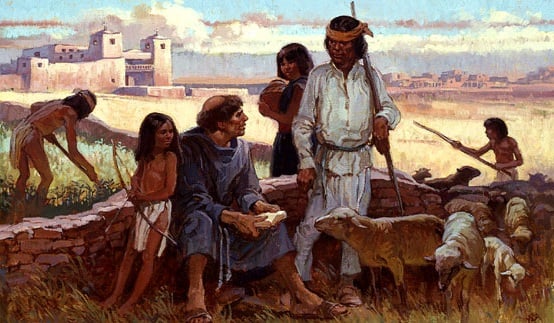The Pueblos: 1700 to 1725

In 1680, the Pueblos of New Mexico revolted against the Spanish and drove them from the region. A decade later, however, the Spanish returned and began their re-conquest of New Mexico. In 1696, eleven Pueblo villages along the Rio Grande revolted again against the Spanish, but the revolt was quickly crushed. By 1700 the Spanish were again firmly entrenched in the region and for the next generation the Pueblo people had to adjust to the Spanish, their strange religion, and their insistence that the Pueblos totally submit to Spanish rule.
Conflicts with the Spanish:
Adjustment to the return of the Spanish and their priests was not always peaceful. In northern Arizona, the Hopi attacked and destroyed the Spanish occupied village of Awatovi in 1700. The Spanish priests and their male converts were sealed in a kiva and then suffocated by having hot ground chilies poured in through the roof opening. The women and children were taken to other Hopi villages. Some of the Hopi survivors from Awatovi were taken in by the Navajo where they founded the Tobacco Clan.
In 1703, three of the Spanish soldiers sent to protect the priest at Zuni were killed by the Zuni. The soldiers had been living with Zuni women.
In 1706, the Spanish re-established Galisteo Pueblo and re-named it Nuestra Señora de los Remedios. They forced 90 Indians to live in the pueblo.
Also in 1706, the Franciscan friar noted that the mission at Cochití Pueblo had a bell without a clapper. He wrote:
“The Indians took all the clappers away, to make lances and knives.”
In 1719, Spanish authorities tried a Taos man for having drunk a beverage made with peyote. The Spanish felt that peyote was associated with black magic and that it gave visions to witches.
Villages:
During this re-adjustment period, some Pueblo villages were abandoned; some were relocated; some older village sites were re-occupied; and some new villages were established.
In 1700, the Zuni re-occupied the village of Halona (present-day Zuni Pueblo). At this same time, the pueblo of San Felipe on top of Black Mesa was abandoned and a new pueblo was constructed at the foot of the mesa.
In 1702, a group of Tewa from New Mexico sought refuge among the Hopi in Arizona. The Hopi chief did not fulfill the promise of land until they demonstrated their prowess. The Tewa defeated a Ute attack and were given a site on First Mesa where they built the village of Hano.
That same year, the Jemez returned to their valley and resettled on an earlier village site.
In 1706, the people of Picuris pueblo, decimated by disease and warfare, returned to their pueblo from their exile in Kansas. They had fled their homeland during the Pueblo Revolt of 1696.
In 1709, the Spanish government approved the purchase of land at the mouth of the Río Jémez by nine Indians from Santa Ana Pueblo. The seller was Spanish colonist Manuel Baca. In order to regain their farm lands which had been lost through the Spanish land grants, Santa Ana Pueblo had started to buy these lands back from the Spanish settlers. First, they had to wait until the settler was ready to sell the land, and then they had to petition the Spanish government for permission to buy it. Then all parties had to agree on the price, the land’s boundaries, and the terms of the sale.
In 1716, some of the people who had fled from Jemez following the Pueblo Revolt of 1696 returned to the village from Walpi in Hopi country.
Pottery:
In 1700, Pueblo pottery began to change in shape and decoration. Previously, the Pueblo potters had used a lead glaze, but this process was abandoned and the potters began to substitute pigments made from ores which were rich in iron or manganese. This produced a dark brown to black look.
The potters at Acoma Pueblo began making a type of pottery known as Ako Polychrome. The Ako Polychrome jars have a top-heavy, mushroom-shaped upper body with a wide bulge at about the middle of the jug. There is a very short neck and a tapered underbody. A range of small motifs, including feather clusters, was used for decoration.
An example of an Ako Polychrome jar can be found
at Fenimore Art Museum.
http://www.fenimoreartmuseum.o…
The potters at Santa Ana and Zia developed a new style of pottery which archaeologists call Purname Polychrome. Many of the jars have a motif consisting of a cluster of bird feathers. Many of the jars from Zia have a band of red or black arcs around the circumference below the main design area.
At Zuni, Potters began using concave bases for jars, a style which may have been borrowed from the southern Tewa. The new style of pottery, which is decorated with red and black matte mineral paints, is known as Ashiwi Polychrome.



